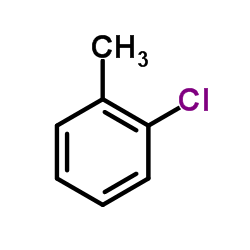2-Chlorotoluene

2-Chlorotoluene structure
|
Common Name | 2-Chlorotoluene | ||
|---|---|---|---|---|
| CAS Number | 95-49-8 | Molecular Weight | 126.584 | |
| Density | 1.082 | Boiling Point | 157-159 ºC | |
| Molecular Formula | C7H7Cl | Melting Point | -36 ºC | |
| MSDS | Chinese USA | Flash Point | 47 ºC | |
| Symbol |



GHS02, GHS06, GHS08 |
Signal Word | Danger | |
|
QSPR modeling of octanol/water partition coefficient for vitamins by optimal descriptors calculated with SMILES.
Eur. J. Med. Chem. 43 , 714-40, (2008) Simplified molecular input line entry system (SMILES) has been utilized in constructing quantitative structure-property relationships (QSPR) for octanol/water partition coefficient of vitamins and organic compounds of different classes by optimal descriptors.... |
|
|
Vibrational spectroscopic analysis of 2-chlorotoluene and 2-bromotoluene: A combined experimental and theoretical study
Spectrochim. Acta. A. Mol. Biomol. Spectrosc. 77(5) , 1005-13, (2010) In this work, the vibrational spectral analysis was carried out using Raman and infrared spectroscopy in the range 100–4000 cm −1 and 50–4000 cm −1, respectively, for the title molecules. The molecular structure, fundamental vibrational frequencies and intens... |
|
|
Molecular structure and vibrational spectra of o-chlorotoluene, m-chlorotoluene, and p-chlorotoluene by ab initio HF and DFT calculations.
Spectrochim. Acta. A. Mol. Biomol. Spectrosc. 78(3) , 1126-32, (2011) In this work, experimental and theoretical study on the molecular structure and the vibrational spectra of o-chlorotoluene (OCT), m-chlorotoluene (MCT) and p-chlorotoluene (PCT) are presented. The vibrational frequencies of these compounds were obtained theor... |
|
|
[Establishment of the maximum permissible concentrations of o- nd p-chlorotoluenes in reservoir water].
Gig. Sanit. (2) , 67-8, (1981)
|
|
|
Permeation of chlorinated aromatic compounds through Viton and nitrile glove materials.
Am. Ind. Hyg. Assoc. J. 45(9) , 617-21, (1984) The ASTM cell was utilized to study permeation of chloro-, o-dichloro-, and m-dichloro-benzenes and o- and p-chlorotoluenes through Viton (unsupported) and nitrile (supported and unsupported) glove materials using isopropanol as collecting solvent, and FID/ga... |
|
|
Metabolism of Chlorotoluenes by Burkholderia sp. Strain PS12 and Toluene Dioxygenase of Pseudomonas putida F1: Evidence for Monooxygenation by Toluene and Chlorobenzene Dioxygenases.
Appl. Environ. Microbiol. 63(5) , 1974-9, (1997) The degradation of toluene by Pseudomonas putida F1 and of chlorobenzenes by Burkholderia sp. strain PS12 is initiated by incorporation of dioxygen into the aromatic nucleus to form cis-dihydrodihydroxybenzenes. Toluene-grown cells of P. putida F1 and 3-chlor... |
|
|
Degradation of 2-chlorotoluene by Rhodococcus sp. OCT 10.
Appl. Microbiol. Biotechnol. 93(5) , 2205-14, (2012) A strain Rhodococcus sp. OCT 10 DSM 45596(T), exhibiting 99.9% of 16S rDNA identity with Rhodococcus wratislaviensis NCIMB 13082, was isolated from a soil sample. The strain completely mineralised 2-chlorotoluene, 2-bromotoluene, o-xylene, benzyl alcohol and ... |
|
|
Chloromethylmuconolactones as critical metabolites in the degradation of chloromethylcatechols: recalcitrance of 2-chlorotoluene.
J. Bacteriol. 187(7) , 2332-40, (2005) To elucidate possible reasons for the recalcitrance of 2-chlorotoluene, the metabolism of chloromethylcatechols, formed after dioxygenation and dehydrogenation by Ralstonia sp. strain PS12 tetrachlorobenzene dioxygenase and chlorobenzene dihydrodiol dehydroge... |
|
|
[Estimation of bioconcentration factor of benzene derivatives].
Ying Yong Sheng Tai Xue Bao 17(12) , 2399-402, (2006) To estimate the bioconcentration factor (BCF) of benzene derivatives in fish by gas chromatography retention time (t(R)), this paper measured the BCF of chlorobenzene, o-chloro-toluene, p-dichlorobenzene, m-dichlorobenzene, 1,2-dichlorobenzene, nitrobenzene, ... |
|
|
Metabolic engineering of bacteria for environmental applications: construction of Pseudomonas strains for biodegradation of 2-chlorotoluene.
J. Biotechnol. 85(2) , 103-13, (2001) In this article, we illustrate the challenges and bottlenecks in the metabolic engineering of bacteria destined for environmental bioremediation, by reporting current efforts to construct Pseudomonas strains genetically designed for degradation of the recalci... |